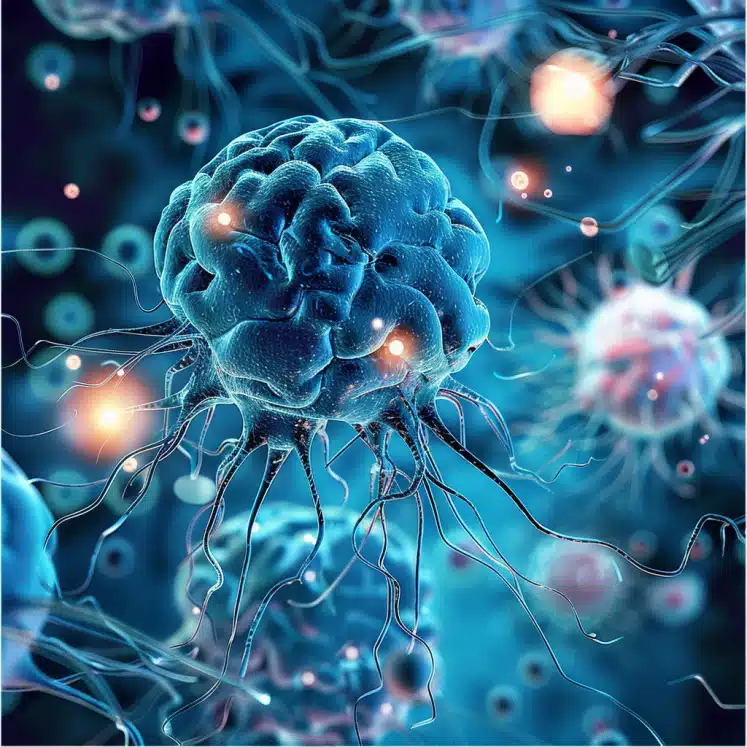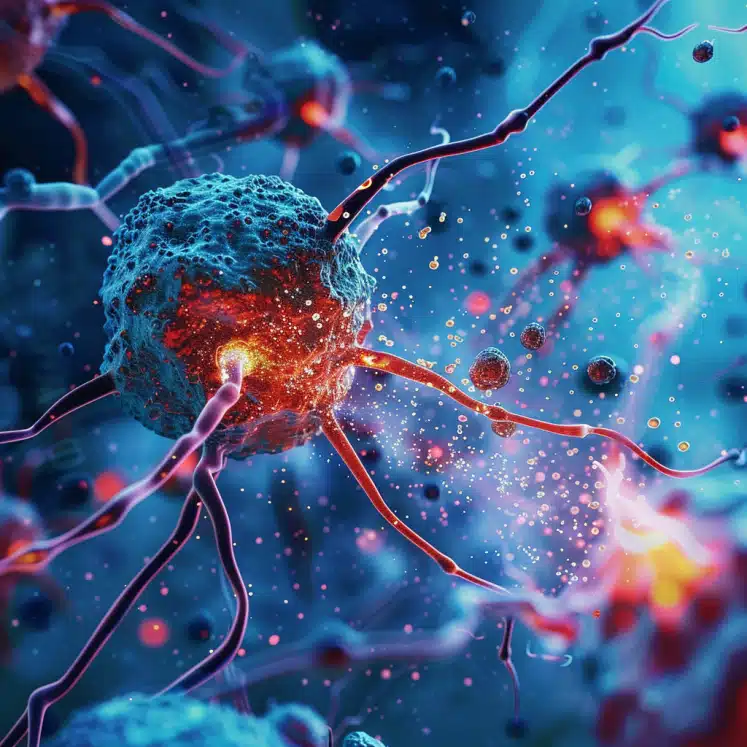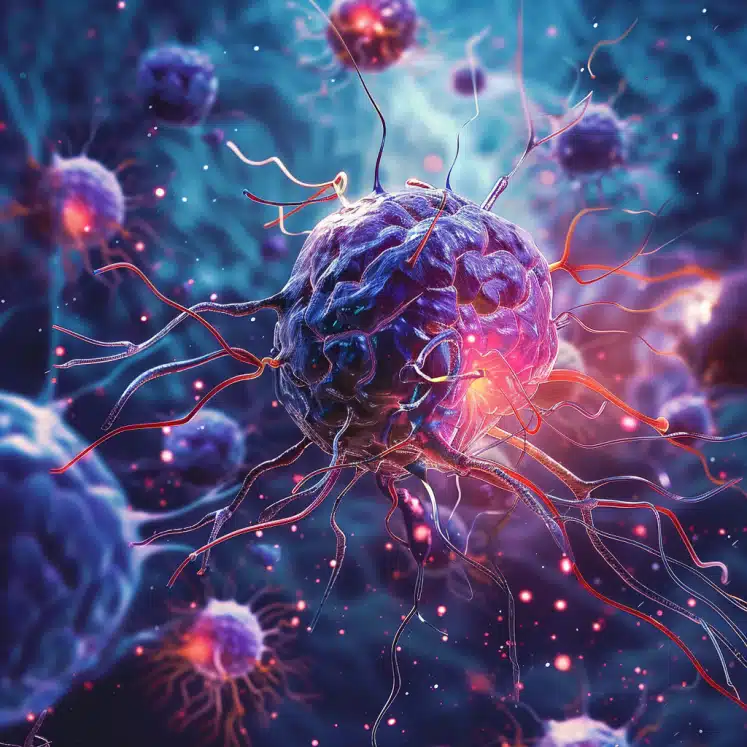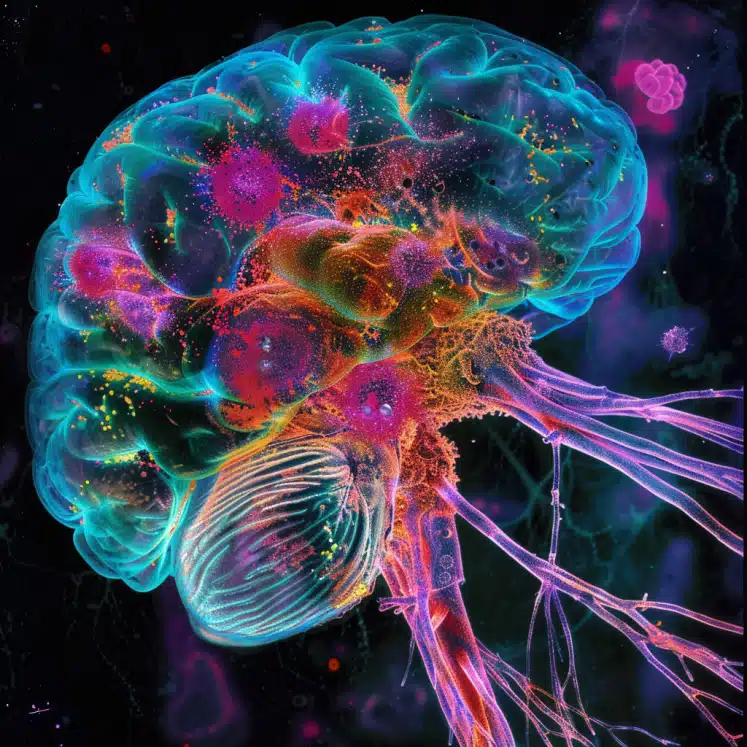Nanoparticle-enhanced radiotherapy (NERT) is a promising approach to improving brain tumor treatment by enhancing radiotherapy efficacy through targeted delivery and radiosensitization while overcoming challenges posed by the blood-brain barrier.
Highlights:
- Mechanisms of Action: NERT utilizes nanoparticles (NPs) as radiosensitizers, enhancing radiation-induced damage through physical dose enhancement and biological/chemical sensitization.
- Types of Nanoparticles: Various NP types, including metallic, polymeric, and lipid-based, have shown potential in preclinical models for targeting and treating brain tumors.
- Blood-Brain Barrier: NPs designed with optimal size (20–100 nm), surface charge, and targeting ligands can effectively cross the blood-brain barrier and accumulate in tumor tissues.
- Preclinical Success: Preliminary studies demonstrate improved tumor control and survival benefits with NERT, although clinical trials are still in early phases focusing on safety and efficacy.
Source: Frontiers in Pharmacology (2024)
How Nanoparticles Work in Brain Tumor Treatment
1. Crossing the Blood-Brain Barrier (BBB)
Size & Charge Optimization: NPs are designed to be small enough (20-100 nm) to cross the BBB while avoiding rapid clearance from the bloodstream.
Surface Functionalization: NPs can be modified with ligands or peptides that target receptors on the BBB, facilitating receptor-mediated transcytosis.
2. Targeted Delivery
Enhanced Permeability and Retention (EPR) Effect: Tumors often have leaky vasculature, allowing NPs to accumulate preferentially in tumor tissues.
Active Targeting: NPs can be functionalized with antibodies or other molecules that specifically bind to tumor cells, ensuring more precise delivery of therapeutic agents.
3. Radiosensitization
Physical Dose Enhancement: High-Z material-based NPs, such as gold, enhance the local radiation dose by generating secondary electrons and reactive oxygen species upon radiation exposure.
Biological/Chemical Sensitization: NPs can deliver radiosensitizing agents directly to tumor cells, altering cellular pathways and making them more susceptible to radiation.
Research Facts: Nanoparticle-Enhanced Radiotherapy (NERT) for Brain Tumors (2024)

1. Mechanisms of Action
Nanoparticles (NPs) enhance the efficacy of radiotherapy through two primary mechanisms: physical dose enhancement and biological/chemical sensitization.
- Physical Dose Enhancement: NPs, particularly those made of high-Z materials like gold, increase the local radiation dose within the tumor. When exposed to radiation, these NPs generate secondary electrons and reactive oxygen species, intensifying the damage to tumor cells.
- Biological/Chemical Sensitization: NPs can deliver radiosensitizing agents directly to tumor cells. These agents alter cellular pathways and the tumor microenvironment, making cancer cells more susceptible to radiation.
2. Types of Nanoparticles
The study explored various types of nanoparticles, each with unique properties and applications in brain tumor treatment:
- Metallic Nanoparticles: Gold and silver NPs are effective in enhancing radiation effects due to their high atomic number, which leads to better absorption of radiation energy.
- Polymeric Nanoparticles: These NPs can encapsulate drugs and release them in a controlled manner. They are biocompatible and can be engineered for specific targeting.
- Lipid-Based Nanoparticles: These mimic cell membranes, making them highly compatible with biological systems. They can cross the blood-brain barrier (BBB) efficiently and deliver drugs or genetic material directly to tumor cells.
- Magnetic Nanoparticles: These can be directed to tumor sites using external magnetic fields, enabling precise delivery and hyperthermia treatment (localized heating to kill tumor cells).
3. Crossing the Blood-Brain Barrier (BBB)
One of the significant challenges in treating brain tumors is the BBB, which prevents most therapeutic agents from reaching the brain.
The study highlighted strategies to overcome this barrier:
- Optimal Size and Charge: NPs sized between 20-100 nm with a neutral or slightly negative charge are most effective at crossing the BBB.
- Targeting Ligands: Functionalizing NPs with ligands like transferrin or peptides can facilitate receptor-mediated transcytosis, allowing NPs to cross the BBB more efficiently.
- Temporary BBB Disruption: Techniques like focused ultrasound (FUS) or osmotic agents can temporarily open the BBB, enhancing NP delivery to the brain.
4. Preclinical Success
Preclinical studies have shown promising results for NERT:
- Enhanced Tumor Control: NPs used in conjunction with radiotherapy significantly improve tumor control and prolong survival in animal models.
- Improved Survival Rates: The use of NPs as radiosensitizers has demonstrated better survival rates compared to traditional radiotherapy alone.
- Combination Therapies: NPs have been successfully combined with chemotherapy and immunotherapy, showing synergistic effects that enhance overall treatment efficacy.
5. Clinical Considerations and Challenges
While NERT shows great promise, several challenges need to be addressed for clinical adoption:
- Safety and Toxicity: Ensuring the biocompatibility and safety of NPs is crucial. Long-term toxicity and the potential for immune reactions need thorough investigation.
- Regulatory Hurdles: The complex regulatory landscape requires standardized protocols for NP production, characterization, and clinical testing.
- Tumor Heterogeneity: The diverse nature of brain tumors necessitates personalized approaches to NP design and treatment protocols.
6. Future Directions
The study outlines several future directions for NERT:
- Refinement of NP Formulations: Developing multifunctional NPs that can deliver drugs, enhance radiation, and monitor treatment response in real-time.
- Personalized Medicine: Tailoring NP-based therapies to the specific genetic and molecular profiles of individual patients’ tumors.
- Combination Approaches: Integrating NERT with other treatment modalities such as immunotherapy, chemotherapy, and targeted therapies to improve outcomes.
- Regulatory Pathways: Collaborating with regulatory bodies to establish clear guidelines for the safe and effective clinical translation of NERT.
Conclusion: NERT for Brain Tumor Treatment
Nanoparticle-enhanced radiotherapy (NERT) presents a promising advancement in the treatment of brain tumors, offering significant potential to overcome the limitations of conventional therapies by enhancing radiation efficacy and enabling targeted delivery.
The study demonstrated that various types of nanoparticles, such as metallic, polymeric, and lipid-based, can effectively cross the blood-brain barrier and act as radiosensitizers, thereby improving tumor control and survival rates in preclinical models.
However, challenges such as long-term toxicity, regulatory hurdles, and tumor heterogeneity must be addressed before NERT can be widely adopted in clinical settings.
Future research should focus on refining nanoparticle formulations, ensuring safety, and developing personalized treatment approaches to maximize the therapeutic potential of NERT for patients with brain tumors.
References
- Study: Breaking the barrier: Nanoparticle-enhanced radiotherapy as the new vanguard in brain tumor treatment (2024)
- Authors: Shi Feng Liu et al.









